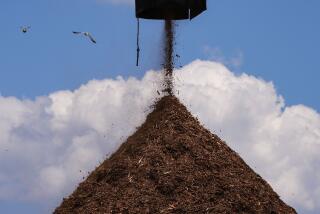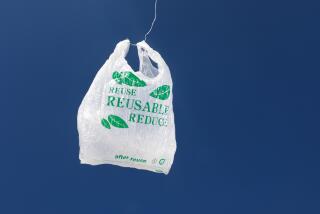Canadian Mill’s Quandary: Can It Make Money on Pollution-Free Paper? : Environment: The company is producing a new kind of paper without toxic chemicals. But it isn’t certain if customers will pay more for it.
PORT MELLON, Canada — The U.S. Environmental Protection Agency identified pulp mills as a significant source of toxic water pollution in 1985, and steadily since then, environmentalists have pressed the industry to find a way to make softwood pulp without using chlorine.
Chlorine bleaches wood pulp to a brilliant, commercially appealing white without weakening the fibers--but in the process, it combines with compounds present in wood to make toxic chemicals of the infamous organo-chlorine family. Dioxin is the most notorious.
These byproducts wash away in pulp mill effluents and soon turn up in rivers. There, environmentalists say, they work their way up the food chain, causing deformities in fish, reproductive failures in birds and probably other disruptions in the plant and animal world yet unknown.
“When it comes to water, right now the pulp and paper industry is the king polluter in North America,” says Mark Floegel, a pulp and paper campaigner with Greenpeace who works in Washington.
The industry, meanwhile, has responded that it has made a good-faith search and has found no other substance that can bleach softwood pulp with the ease of chlorine. Everything researchers have tried, the industry says, yields either paper that is dingy to the eye, paper that shreds when run through high-speed printing presses--or paper that costs so much that no one will buy it.
With environmentalists saying, “Yes, you can,” and industrialists saying, “No, we can’t,” chlorine-free pulp has been the subject of a standoff--until now.
A pulp mill in this tiny British Columbia community north of Vancouver has become the first in North America to make the high-grade, chlorine-free softwood pulp that the environmentalists have been insisting on all these years.
“My hope is . . . that this is the first chink of light we’re seeing in the wall,” Floegel says. “There are still producers in America who say this is impossible to do, even as we thrust pieces of chlorine-free paper into their faces.”
The mill in question is Howe Sound Pulp and Paper Ltd., jointly owned by Canfor Corp., a mid-sized forest-products concern based in Vancouver, and Oji Paper Co., a large Japanese producer.
The Howe Sound mill, named for the tree-lined body of water on which it stands, has made just two shipments of its chlorine-free pulp so far. One went out in October and the other in February. Both were experimental.
“We’re really in what I call the Model-T stage,” says Howe Sound president William Hughes, explaining that he wants to see how well the pulp performs in the market before deciding whether to go to full-scale production.
The trick, he says, will be to see whether the market’s money is where the environmental movement’s mouth is. Howe Sound’s pulp is decidedly cream-colored--not gleaming white--and Hughes needs proof that off-white pulp can command premium prices just because it is environmentally friendly.
Throughout the pulp and paper industry, competitors are closely watching Howe Sound’s experiment.
Softwood pulp has traditionally been a mainstay of the Canadian economy, but now the industry is in its worst slump since the Great Depression. In 1991, Canadian pulp and paper manufacturers lost about $1.3 billion. Among them, mid-sized Canfor reported a loss of $82.6 million, the worst annual loss in company history.
The industry’s problems are many: The strong Canadian dollar is making exporting difficult; the land base of available forest is shrinking; competition from low-cost U.S. producers is intensifying; environmentalists are ascendant, and the government seems to be listening to them, tightening logging and water-pollution regulations.
In January, British Columbia’s Social Democratic environment minister, John Cashore, announced that the province’s pulp mills would have to eliminate all organo-chlorines from their effluent by the year 2002.
That new standard will give British Columbia the toughest pulp mill effluent requirements in North America.
The announcement outraged executives at most of the province’s 23 pulp mills, who say they have already spent, collectively, close to $1 billion on technology to reduce the organo-chlorine content of their effluent. In essence, what they did was replace pure chlorine with chlorine dioxide on their production lines.
Taking the level of contaminants all the way down to zero, they say, requires a wholly different technology--one that does without chlorine or chlorine dioxide. Setting a zero-chlorine requirement at this point, they say, means their costly investment in chlorine dioxide has been for nothing.
The industry says further that the cost of retooling for British Columbia’s new regulations could be as much as $175 million at some mills. And few executives are volunteering to make such outlays in the midst of a painful shakeout. Instead, they are hinting that they will just run their mills until the year 2002--when the tough regulations must be fully implemented--and then shut down.
Only Howe Sound--which, incidentally, was one of the province’s worst dioxin offenders as recently as 1988--has decided to try a different approach.
Howe Sound embarked on an $880-million plant modernization in 1988, when the pulp and paper industry was booming. As part of its overhaul, management decided to put in $100 million of equipment that could meet whatever environmental regulations the future might bring. Part of the investment went to the chlorine-dioxide technology that may soon be obsolete. But Howe Sound also put in equipment for making chlorine-free pulp.
“Anybody who builds a mill according to existing standards is an ass,” Hughes says.
Hughes insists that experimenting with chlorine-free pulp has been a business decision, not a nod to the environmental movement. (The pulp and paper industry continues to insist that small amounts of organo-chlorine compounds are not harmful.)
“There’s a business maxim which says, ‘When a commodity market sags, specialize,’ ” Hughes says.
Standard pulp now sells for $475 per metric ton; Hughes hopes his innovative, chlorine-free pulp may have a premium of as much as $70 over that, but won’t know until his market tests are done.
As a result of the renovations, Howe Sound is now set up to bleach pulp with oxygen and hydrogen peroxide instead of with chlorine and chlorine dioxide. (There are other steps in Howe Sound’s process, but Hughes won’t reveal what they are.)
Hughes’ marketing attentions are now focused mainly on Germany, which accounts for about a quarter of Howe Sound’s business. Environmental activists there have been putting tremendous pressure on magazine publishers lately, and Hughes says the publishers have been asking about chlorine-free paper for about a year.
The pressure has come largely from Greenpeace, which targeted the publisher of the German news weekly Der Spiegel in the spring of 1991. Greenpeace bought some chlorine-free paper and published a parody of Der Spiegel called “Das Plagiat,” or The Plagiarist. It looked just like Der Spiegel but contained nothing but articles about the environment.
Readers couldn’t help noticing that Das Plagiat’s environmentally friendly paper looked exactly like Der Spiegel’s standard paper. Indignant, they started asking why Der Spiegel couldn’t just as well use chlorine-free paper too. Der Spiegel has not started using chlorine-free paper, but indicated that it might if it could be guaranteed a constant supply.
Something similar happened more recently in the United States, where Greenpeace went after Time Warner Inc. The group sent about 200,000 letters to its supporters, urging them to write the huge media conglomerate and demand that it use chlorine-free paper. About 22,000 Greenpeacers obliged.
Time magazine, in turn, announced in its Jan. 20 issue that it would use chlorine-free paper as soon as there was enough on the market. So far, there isn’t enough to go around. Only a handful of mills in Sweden, Finland, Spain and now Canada can make it.
Here in Port Mellon, Hughes is shaking his head over the whole affair. He is glad enough that there may be a new market for his specialty pulp at a time when standard pulp is hard to sell. But he is as angry as any of his competitors that the government wants to ban low-chlorine pulp in the next decade. Hughes believes that the push for chlorine-free pulp is based on emotion rather than science.
“If you wanted to tackle the most important environmental problem in our society, would you start with pulp mills?” he asks. “I wouldn’t. I’d start with cars. How many people have been killed by pulp-mill effluent?”
He adds that trace amounts of organo-chlorines can be found everywhere--even in spit.
Retorts Floegel: “One of the reasons you can find (them) in spit is the pulp and paper industry. They have made (organo-chlorines) ubiquitous.”
More to Read
Sign up for Essential California
The most important California stories and recommendations in your inbox every morning.
You may occasionally receive promotional content from the Los Angeles Times.










